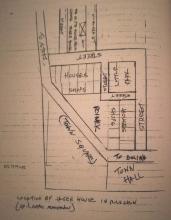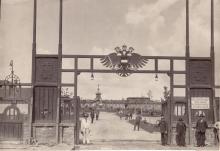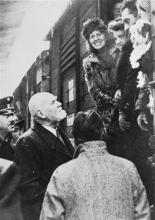Venue: Library of CEFRES, Na Florenci 3, Prague 1.
Organized by the Masaryk Institute and Archives of the Czech Academy of Sciences, CEFRES and the Prague Center for Jewish Studies.
All presentations will be in English.
Contact: Daniela Bartáková, bartakova@mua.cas.cz
1. October 2019 5:30pm
The Afterlife of Yizker bikher in Contemporary Jewish Writing
 Marianne Windsperger (Vienna Wiesenthal Institute for Holocaust Studies)
Marianne Windsperger (Vienna Wiesenthal Institute for Holocaust Studies)
In my PhD dissertation project on “Revisiting and Retelling the Shtetl: Narratives of Searching for Traces in American Jewish Writing” I devote a chapter to references to the yizker bukh tradition in contemporary Jewish writing. The Yiddish term yizker bikher has come to describe a large body of books commemorating destroyed Jewish communities in Eastern Europe. These books have been put together in displaced persons camps immediately after the war or in the hometown societies, the landsmanshaftn. A large number of the yizker bikher include various materials such as maps, photographs, documents as well as lists of names. In narratives that seek to draw transgenerational connections to concrete places, these memorial books are consulted to gain or verify knowledge on specific sites and as a repository of names of the former inhabitants. In this chapter I will carefully trace forms of collecting and writing in contemporary Jewish literature connected to the yizker bukh tradition. Traces of the diasporic medium of the yizker bikher can be found in contemporary American writing, in Argentinian literature as well as in French and German works. Through a comparative approach I will map the afterlife of this genre in world literature and show how these books draw together various writing traditions.
22. October 2019 5:30pm
Refugee camps in Bohemia and Moravia in the WWI
 Alena Jindrová (Muzeum Vysočiny Havlíčkův Brod)
Alena Jindrová (Muzeum Vysočiny Havlíčkův Brod)
During the WWI, refugees came mainly to the central parts of monarchy – Bohemia, Moravia and Austrian lands (Carinthia, Carniola, Lower Austria, Upper Austria). As the war broke out, the first camps were hastily built and transports of refugees were organized by the authorities. But many people fled their houses in chaos and were unable to support themselves. My research project focuses on the refugee camps in the Czech lands and the institutions that were in charge of refugees. So far, no summarizing study deals with the history of refugee camps in the area of the present Czech Republic, such as the large camps in Havlíčkův Brod, Choceň, Kyjov, Mikulov, Pohořelice, Moravská Třebová and Uherské Hradiště. Especially the history of the Moravian camps remains undocumented and we miss even basic a knowledge about when and how they were founded, built, and administrated, and for how many refugees they were intended. I also examine state attempts to control and support refugees and the organization of the aid. Baron Hirsch Fund, Israelitische Alliance in Wien and some regional societies played an important role in providing for the refugees. But in spite of efforts of government and activists, many difficulties remained: research project also focuses on the problematic aspects of the refugee relief, including the history of camps and fates of refugees towards the end of the war.
In cooperation with the “Unlikely refuge?” project.
12. November 2019 5:30pm
Return Home: Holocaust Survivors Reestablishing Lives in Postwar Vienna
 Elizabeth Anthony (US Holocaust Memorial Museum)
Elizabeth Anthony (US Holocaust Memorial Museum)
Of the pre-Anschluss total of more than 200,000 Austrian Jews – both self-identified and those categorized as such by National Socialist “racial” policy – more than 90 percent lived in Vienna. Some 130,000 managed to escape but the Nazis murdered no less than 65,000, and by 8 May 1945, fewer than 6,000 remained alive in the capital city. Some survivors reemerged from hiding immediately upon the Soviets’ conquest of the city and those who had endured internment in concentration camps joined them there shortly thereafter. The majority of Austrian Jews who survived in exile remained abroad, but a few thousand also returned to reestablish lives in Vienna.
Why lay down roots anew in a homeland from which they had been deported or expelled, and why choose to live among former compatriots who neither expected nor desired their return? What did survivors expect to find in Vienna? What reality did they encounter? And why did they stay? This presentation elucidates the different concepts of familial home, political home, and professional home that inspired a handful of Viennese Jews to go back to their hometown. It analyzes the first opportunities survivors took to exert personal agency for their futures in the immediate postwar period with their emotional, political, and professional reconnection to Viennese society.
